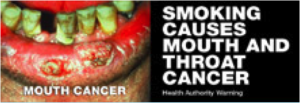Freakonomics Poll: Will New Cigarette Warning Labels Reduce Smoking?
 Photo: kadavy
Photo: kadavySoon, new warning labels on cigarette packs will have even scarier messages, and photos too. Canada has been doing this for years. Will it reduce smoking?
Here are three quick thoughts.
1) I strongly doubt it will increase the quantity of information about smoking. Folks know it is bad for you already.
2) This does not mean it won’t work. Maybe people try to forget the health risks in that moment of passion (folks know birth control helps prevent pregnancy, but similarly, when faced with impending temptations, magically forget such trivial details). Will these photos remind them at that moment of temptation? Maybe. Or maybe it will increase how often their kids or friends give them grief for it, thus creating some social pressure to stop. Naturally there is a counter-argument, that this may enhance teenage smoking, if “being bad” makes it cooler.
3) We do have some related evidence on this. It doesn’t bode well for the messages and photos. A few years ago Levitt blogged here about a commitment contract randomized trial I did in the Philippines. The commitment contracts worked great to reduce smoking for those who would sign a contract (disclosure: these contracts are designed similarly to stickK.com, a corporate wellness program and personal behavior modification website I co-founded with Ian Ayres, except minus the internet). And 11% signed a contract, which is really high for any consumer products or services firm, but low if your goal is to eliminate smoking entirely.
The commitment contracts treatment arm was the main point, but there was a placebo group which didn’t get much attention. Messages and photos!
 A group also received a card to keep in their wallet or home. The card had nasty photos of black lungs and throat cancer. Spot checks conducted during the study found that folks knew where their card was, they didn’t just throw it away.
A group also received a card to keep in their wallet or home. The card had nasty photos of black lungs and throat cancer. Spot checks conducted during the study found that folks knew where their card was, they didn’t just throw it away.
 After one year, we found that the cue card barely made a dent in smoking, a reduction of 0.9 percentage points (at 95% confidence, +/- 3.1 percentage points). At six months the point estimate was slightly higher (1.5 – 2.2 percentage points), but still not statistically significant. Hardly a resounding success, and a decently small confidence interval, so the null effect we believe was truly a sign of an ineffective treatment.
After one year, we found that the cue card barely made a dent in smoking, a reduction of 0.9 percentage points (at 95% confidence, +/- 3.1 percentage points). At six months the point estimate was slightly higher (1.5 – 2.2 percentage points), but still not statistically significant. Hardly a resounding success, and a decently small confidence interval, so the null effect we believe was truly a sign of an ineffective treatment.
In fairness to the CDC’s new messages and photos, this was not the same as putting the messages and photos on the cigarette packages themselves. There is a constancy in putting it on the packages themselves that maybe is essential to make this work? (Although I also suspect this policy will now create a new line of products for cigarette package covers, to cover up the nasty photos. This could be like a new fashion statement, changing every week with your ringtone.)
There is hope though: another study, here, found that sending frequent text messages to encourage individuals to stop smoking had a big effect. The timing here is different, and in a potentially important way. These messages came throughout the day, not at the moment of passion. Imagine sending someone frequent messages throughout the week to practice safe sex, compared to just tapping someone on the shoulder immediately before the act to remind them. I strongly suspect the former would be more effective than the latter.
So what will the net effect be, fewer smokers or more smokers?
[poll id=”15″]

Comments